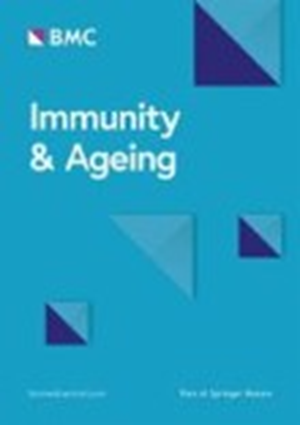Role of germinal center and CD39highCD73+ B cells in the age-related tonsillar involution
IF 5.2
2区 医学
Q1 GERIATRICS & GERONTOLOGY
引用次数: 0
Abstract
The tonsils operate as a protection ring of mucosa at the gates of the upper aero-digestive tract. They show similarities with lymph nodes and participate as inductive organs of systemic and mucosal immunity. Based on the reduction of their size since puberty, they are thought to experience involution in adulthood. In this context, we have used tonsillar mononuclear cells (TMC) isolated from patients at different stages of life, to study the effect of ageing and the concomitant persistent inflammation on these immune cells. We found an age-dependent reduction in the proportion of germinal center B cell population (BGC) and its T cell counterpart (T follicular helper germinal center cells, TfhGC). Also, we demonstrated an increment in the percentage of local memory B cells and mantle zone T follicular helper cells (mTfh). Furthermore, younger tonsils rendered higher proportion of proliferative immune cells within the freshly isolated TMC fraction than those from older ones. We demonstrated the accumulation of a B cell subset (CD20+CD39highCD73+ cells) metabolically adapted to catabolize adenosine triphosphate (ATP) as patients get older. To finish, tonsillar B cells from patients at different ages did not show differences in their proliferative response to stimulation ex vivo, in bulk TMC cultures. This paper sheds light on the changing aspects of the immune cellular landscape, over the course of time and constant exposure, at the entrance of the respiratory and digestive systems. Our findings support the notion that there is a re-modelling of the immune functionality of the excised tonsils over time. They are indicative of a transition from an effector type of immune response, typically oriented to reduce pathogen burden early in life, to the development of an immunosuppressive microenvironment at later stages, when tissue damage control gets critical provided the time passed under immune attack. Noteworthy, when isolated from such histologic microenvironment, older tonsillar B cells seem to level their proliferation capacity with the younger ones. Understanding these features will not only contribute to comprehend the differences in susceptibility to pathogens among children and adults but would also impact on vaccine developments intended to target these relevant mucosal sites.生殖中心和 CD39highCD73+ B 细胞在与年龄相关的扁桃体内陷中的作用
扁桃体是上消化道入口处粘膜的保护环。扁桃体与淋巴结相似,是全身免疫和粘膜免疫的感应器官。根据青春期后扁桃体体积的缩小,我们认为它们在成年后会经历内缩。在这种情况下,我们使用从不同生命阶段的患者身上分离出的扁桃体单核细胞(TMC)来研究衰老和伴随而来的持续炎症对这些免疫细胞的影响。我们发现,生殖中心 B 细胞群(BGC)及其对应的 T 细胞(T 滤泡辅助生殖中心细胞,TfhGC)的比例随年龄增长而减少。同时,我们还发现局部记忆 B 细胞和套管区 T 滤泡辅助细胞(mTfh)的比例有所增加。此外,与年龄较大的扁桃体相比,年龄较小的扁桃体在新分离的 TMC 部分中显示出更高比例的增殖性免疫细胞。我们证明,随着患者年龄的增长,B 细胞亚群(CD20+CD39highCD73+细胞)的积累在代谢上适应了三磷酸腺苷(ATP)的分解。最后,不同年龄段患者的扁桃体 B 细胞对体内外大量 TMC 培养物刺激的增殖反应并无差异。这篇论文揭示了随着时间的推移和不断接触,呼吸系统和消化系统入口处的免疫细胞状况的变化。我们的研究结果支持这样一种观点,即随着时间的推移,切除扁桃体的免疫功能会发生重塑。这些研究结果表明,在生命的早期阶段,免疫反应通常以减少病原体负担为导向,而到了晚期阶段,当组织损伤控制变得至关重要时,免疫攻击的作用就会逐渐减弱,从而形成免疫抑制微环境。值得注意的是,当从这种组织学微环境中分离出来时,较老的扁桃体 B 细胞的增殖能力似乎与较年轻的扁桃体 B 细胞持平。了解这些特征不仅有助于理解儿童和成人对病原体的易感性差异,还将对针对这些相关粘膜部位的疫苗开发产生影响。
本文章由计算机程序翻译,如有差异,请以英文原文为准。
求助全文
约1分钟内获得全文
求助全文
来源期刊

Immunity & Ageing
GERIATRICS & GERONTOLOGY-IMMUNOLOGY
CiteScore
10.20
自引率
3.80%
发文量
55
期刊介绍:
Immunity & Ageing is a specialist open access journal that was first published in 2004. The journal focuses on the impact of ageing on immune systems, the influence of aged immune systems on organismal well-being and longevity, age-associated diseases with immune etiology, and potential immune interventions to increase health span. All articles published in Immunity & Ageing are indexed in the following databases: Biological Abstracts, BIOSIS, CAS, Citebase, DOAJ, Embase, Google Scholar, Journal Citation Reports/Science Edition, OAIster, PubMed, PubMed Central, Science Citation Index Expanded, SCImago, Scopus, SOCOLAR, and Zetoc.
 求助内容:
求助内容: 应助结果提醒方式:
应助结果提醒方式:


